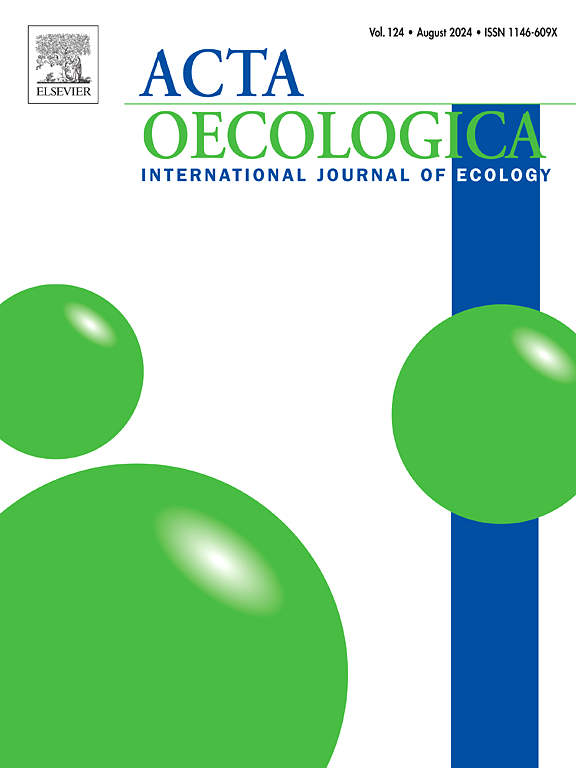Combined restoration techniques underperform in alien grass-dominated sandy soils: Lessons from southern Brazil
IF 1.3
4区 环境科学与生态学
Q3 ECOLOGY
Acta Oecologica-International Journal of Ecology
Pub Date : 2025-07-26
DOI:10.1016/j.actao.2025.104105
引用次数: 0
Abstract
The study aimed to define techniques that favor the ecological restoration of a degraded area with abundance of invasive alien species (IAS) and sandy soil poor in organic matter, as well as to determine factors that can interfere with ecological restoration. The study area is located on the left bank of the Forqueta River in the municipality of Travesseiro, Rio Grande do Sul, Brazil. The area exhibits low levels or organic matter and high levels of macro and micronutrients, and is mostly dominated by invasive alien grasses. Four ecological restoration techniques were applied, constituting five treatments: (1) Planting of seedlings in small clusters - Anderson groups (NA); (2) NA with soil transposition (NA + TS); (3) NA with artificial perches (NA + PA); (4) NA + TS + PA; and (5) natural succession (TC), each with three replications in a completely randomized experimental design. Mechanical mowing and herbicide application were conducted before the application of the techniques, followed by two mechanical mowings at five-month intervals. The evaluation of seedling survival and the monitoring of germination of seeds from transposed soil and around the perches, along with phytosociological sampling at three time (T1 = 3 months; T2 = 9 months; T3 = 13 months), revealed that neither treatment was really successful, and this had several causes, primarily alien species. IAS influenced the reduction of richness and percentage cover of native plant species, regardless of treatment. Soil conditions, low precipitation, and high temperatures also hindered the growth and establishment of native plants. The techniques used did not favor species diversification and the formation of vegetation cover of native plants, thus failing to contribute to local ecological restoration, even when two or three techniques were combined.
综合恢复技术在外来草为主的沙质土壤中表现不佳:来自巴西南部的教训
该研究旨在确定有利于在具有丰富的外来入侵物种(IAS)和有机质贫乏的沙质土壤的退化地区进行生态恢复的技术,以及确定可能干扰生态恢复的因素。研究区域位于巴西南大德州Travesseiro市Forqueta河的左岸。该地区有机质含量低,宏量和微量元素含量高,以外来入侵禾草为主。采用4种生态恢复技术,包括5种处理方法:(1)小丛-安德森群(NA)种植;(2) NA +土壤转位(NA + TS);(3)人工栖木NA + PA;(4) na + ts + pa;(5)自然演替(TC),在完全随机的实验设计中,每个实验有三个重复。在应用该技术之前进行机械刈割和除草剂施用,然后每隔5个月进行两次机械刈割。在换位土壤和栖木周围进行幼苗成活率评价和种子萌发监测,并进行3次(T1 = 3个月;T2 = 9个月;T3 = 13个月),结果显示两种治疗方法都没有真正成功,这有几个原因,主要是外来物种。无论采用何种处理方式,IAS都会导致本地植物物种丰富度和覆盖率的降低。土壤条件、低降水和高温也阻碍了本地植物的生长和建立。即使采用两种或三种技术相结合,也不利于物种多样化和原生植物植被覆盖的形成,因此对当地生态恢复也没有贡献。
本文章由计算机程序翻译,如有差异,请以英文原文为准。
求助全文
约1分钟内获得全文
求助全文
来源期刊
CiteScore
3.60
自引率
0.00%
发文量
57
审稿时长
>0 weeks
期刊介绍:
Acta Oecologica is venue for the publication of original research articles in ecology. We encourage studies in all areas of ecology, including ecosystem ecology, community ecology, population ecology, conservation ecology and evolutionary ecology. There is no bias with respect to taxon, biome or geographic area. Both theoretical and empirical papers are welcome, but combinations are particularly sought. Priority is given to papers based on explicitly stated hypotheses. Acta Oecologica also accepts review papers.

 求助内容:
求助内容: 应助结果提醒方式:
应助结果提醒方式:


